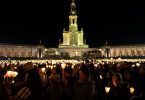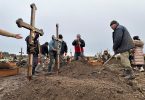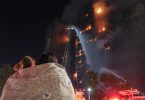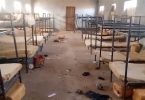Haiti struggles to overcome catastrophic earthquake
by Joe Bollig
joe.bollig@theleaven.org
KANSAS CITY, Kan. — There is an old proverb in Haitian Creole that says, “Deye mon gen mon.”
It means, “Beyond the mountains, there are mountains.”
In other words, even when one challenge is overcome, there are a host of other challenges yet to surmount.
The proverb might as well be the national motto of Haiti, which has struggled to overcome disadvantage, disaster, tragedy and injustice throughout its history.
The latest blow came Jan. 12, when a 7.0 magnitude earthquake occurred about 15 miles west-southwest of Port-au-Prince, the capital of Haiti. That’s 700 miles southeast of Miami, the home of a sizeable Haitian community.
Incredible scenes of suffering and devastation have played out for nearly two weeks on television screens and radio, in newspapers and on the Internet. Governments, private organizations and individuals across the globe have mobilized to help Haiti.
And the death toll estimate keeps rising and rising — perhaps 200,000 dead and tens of thousands more injured. That’s the equivalent of everyone in Topeka, Lawrence and Ottawa suddenly dying. The true Haitian casualty toll may never be known.
But even for a public used to regular disaster reports from around the world, the earthquake in Haiti seems to be especially cruel. That’s because after years of civil disorder, misgovernance, natural disasters and poverty, in recent years it seemed that Haiti had finally found some stability and hope.
Within minutes, decades of painfully won progress were replaced with death, devastation and suffering in a crash and cloud of dust.
“Deye mon gen mon.”
“Beyond the mountains, there are mountains.”
No good place for an earthquake
Even days after seeing the first photos of Haiti’s earthquake devastation, professor Bryan Freeman was stunned.
“I’m numb,” said Freeman. “I just can’t believe it. Buildings I’ve known for 50 years — gone. . . . To think all that doesn’t exist.”
Freeman, a retired professor of Haitian studies at the University of Kansas, was only 26 years old when he first visited Haiti in 1958. He fell in love with the land and its people and learned to speak Creole. He traveled to Haiti often over the past 50 years, staying months at a time.
In his academic career, he has published 20 books about Haiti and a three-volume set on medicine in Haiti. He has also been an instructor and advisor for U. S. and U.N. peace-keeping observers in Haiti.
There is no good place for an earthquake, but some places are worse than others, he said. A case in point is the Haitian earthquake, which damaged almost the entire metropolis of Port-au-Prince, the capital of Haiti. It was the worst place in the entire country for an earthquake to occur.
“Let me put it in perspective,” said Freeman. “Imagine that in one day, New York, Washington, D.C., San Francisco and Chicago were completely devastated. Even that isn’t comparable, because we have a good infrastructure in other places in our country, not just our large cities.”
For better or worse, Haitian life is so centered on the capital that it is sometimes called “The Republic of Port-au-Prince.” The big hospitals, the universities, the largest industries — anything of any consequence in Haiti is in Port-au-Prince. Here’s one telling detail: There are 10 bookstores in Haiti; nine of them are in Port-au-Prince.
“It’s where the action is, and the people who really run Haiti are in this one city,” said Freeman.
A lot of the initial news reporting of the earthquake is misleading, said Freeman. News reports say the quake hit 15 miles outside the city, but that’s like saying Kansas City, Mo., was devastated by a quake in Lenexa. It’s really all one, big, metropolitan area.
And while it’s true that French is one of Haiti’s two official languages, the main language is Haitian Creole, said Freeman. French is spoken by the nation’s elite.
Another piece of outdated information in the news about Haiti is its religion. In his lectures, Freeman used to joke that Haiti is 90 percent Catholic, 10 percent Protestant, and 100 percent voodoo. All three religions are equally recognized by law.
“The truth of the matter is, [Haiti is] 60 percent Catholic and 40 percent Protestant,” said Freeman.
“American Protestantism has made big inroads into Haiti,” he continued. “The Catholic Church is in the towns. The priests don’t want to live in the provinces. Protestant [pastors] usually have a wife and kids and are willing to live out in the rural areas.”
Many of these new, American-initiated churches were built by small, independent Pentecostal or Evangelical denominations. Haitian law requires that when someone builds a church, they also have to build a school and provide some medical services. These latter two hold great appeal to rural peoples who lack access to both.
The poorest of our hemisphere
Saying Haiti is poor isn’t really saying anything, according to Dr. Robert Lorsbach, who grew up a member of Sacred Heart Parish in Gardner.
A lot of news organizations report that Haiti is the poorest country in the Western Hemisphere, but that fact alone fails to paint a complete picture of Haiti’s debilitating poverty, he said.
“I’ve never seen the degree of poverty I’ve seen in Haiti ever in the United States,” said Lorsbach, who made his most recent trip to Haiti in July 2009. “The worst poverty I’ve ever seen here — multiply it by ten and that’s when you begin to understand the level of poverty that exists in Haiti.”
Haiti is almost like two countries in one, said Lorsbach, who made his first trip to bring health supplies to Haiti in 2004, as a member of his former parish in Memphis, Tenn.
One country is Port-au-Prince; the other is rural and small-town Haiti. Tens of thousands of poor Haitians have moved off of their subsistence farms into the city to find a better life. All they found was urban poverty with its crowding, pollution and filth.
“That’s one of the reasons why Port-au-Prince is so hugely overcrowded,” said Lorsbach. “The city infrastructure was never designed to support 2 million-plus residents.”
Lorsbach blames rural Haitian poverty on the importation of cheap American rice, which undercuts Haitian farmers. There are, however, other reasons as well.
One factor is deforestation, which began during colonial times by the plantation owners and continues as the poor cut more trees for cooking fires. Soil erosion is so bad that it is said “the bones” of Haiti — the mountains shorn of their soil — are beginning to show.
Another reason is historical. When Haiti gained its independence, it could only secure the mountainous western one-third of the island of Hispaniola. The Dominican Republic, with the eastern two-thirds, has the better croplands.
A third reason is foreign exploitation, notably by France, which extorted Haiti in the 19th century by threatening invasion. A corrupt Haitian social elite and foreign businesses also bled Haiti’s wealth.
Lorsbach discovered that the medical infrastructure of Haiti is rudimentary at best. One lab he visited was like going 70 years back in time in the United States. In terms of health care or medicine — or anything, for that matter — the national government is no help.
“One of the key things about Haiti is that the people do not rely on the government for anything,” he said. “Here in the U. S., we have government that actually functions and regulates, and provides certain services.”
“The Haitian government provides almost no services whatsoever, particularly in rural areas and the slums in Port-au- Prince,” he said. “As a result, a lot of private groups have stepped in and are now the major players.”
Haiti needs sustained help for years to come, said Lorsbach. He hopes that nations providing earthquake relief will make a long-term commitment to Haitian development after the initial disaster response is over.
Connections of the heart
Despite the distance between northeast Kansas and Haiti, close and personal ties exist. One thread in those ties is Melanie Norris, administrative assistant in the archdiocesan vocations office.
“When I heard this happen, I said, ‘Oh no, not them!’” she said.
Haiti was already desperate before the disaster.
“The best way to sum up their condition is that they don’t even have their basic needs met,” said Norris, who visited Haiti in 1996 with a parish mission group, and again in 1998 with her family.
“[Haiti was] unlike anything that I’ve seen before,” she said. “The government doesn’t provide anything, such as schools and water. They don’t have many roads. They don’t have electricity most of the time.”
Her diary from those times is filled with strange sights: a gas station guarded with a man holding a machine gun; an auto repair shop consisting of a truck by the side of the road and some tires hanging in a tree; a woman selling or bartering fruit all day and earning less than a dollar; and a mountain chapel consisting of a framework of sticks covered with a blue plastic tarp.
The Norrises had hamburgers for lunch during one visit, and their priest/host asked them to save the scraps. Their next stop was at an impoverished mountain mission.
“He would tear off a piece and give it to a child, and the way they received it into their hands was like they had been given gold,” said Norris.
Norris has been trying to find out what happened to the Haitian pastors her family has stayed in contact with for so many years. As of this writing, she has no idea whether they are alive or dead.






